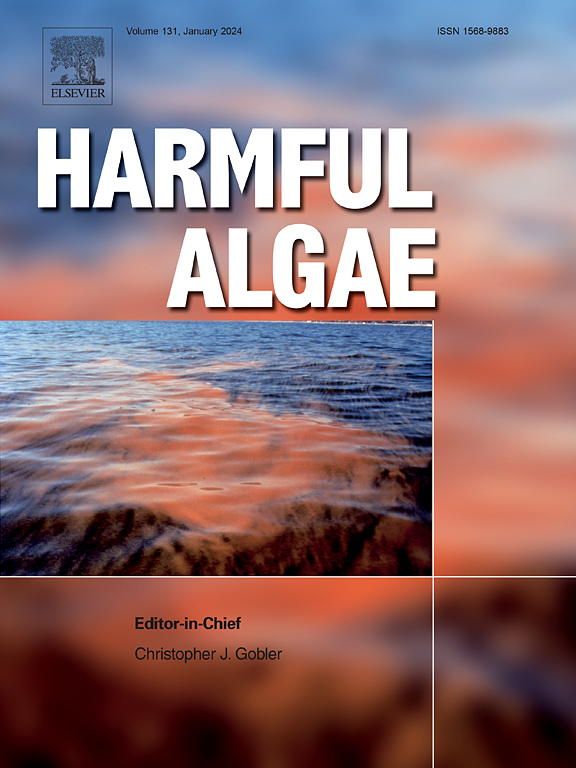Seasonal monitoring of dissolved and particulate algal biotoxins in the northern Salish Sea using high performance liquid chromatography and tandem mass spectrometry
IF 4.5
1区 生物学
Q1 MARINE & FRESHWATER BIOLOGY
引用次数: 0
Abstract
Harmful algae are present in the coastal waters of British Columbia, Canada yet little is known about the spatial and temporal distributions of the biotoxins produced by these organisms. We describe a method for profiling dissolved and particulate algal biotoxins in sea water including those associated with amnesic, paralytic, and diarrhetic shellfish poisoning (ASP, PSP and DSP). Surface sea water was filtered and biotoxins recovered from filters and filtrate using solvent extraction and solid phase extraction, respectively. Extracts were analyzed by high-performance liquid chromatography and tandem mass spectrometry using hydrophilic interaction liquid chromatography for ASP and PSP toxins and reversed-phased liquid chromatography for DSP and other lipophilic toxins. The method was applied to samples collected in the northern Salish Sea in April, June and October 2022. Highest total concentrations of domoic acid and saxitoxin were found above a shallow sill in the eastern Juan de Fuca Strait whereas those of dinophysistoxin 1, pectenotoxin 2, yessotoxin, and PSP toxins C1 and C2 were measured near the southern end of Malaspina Strait. These maximum concentrations were observed in June when surface salinity was lowest, temperature highest, and harmful algae most abundant, as reflected in the relative high proportion of particulate biotoxins. In contrast, the high proportion of dissolved biotoxins observed in April when temperature and algal abundance were relatively low suggests that certain biotoxins may persist in surface waters and that the risk of biotoxin exposure does not necessarily correlate with the abundance of harmful algae.

利用高效液相色谱和串联质谱法对萨利希海北部溶解和颗粒藻生物毒素的季节性监测
加拿大不列颠哥伦比亚省沿海水域存在有害藻类,但人们对这些生物产生的生物毒素的时空分布却知之甚少。我们介绍了一种分析海水中溶解和微粒藻类生物毒素的方法,包括与失忆性、麻痹性和腹泻性贝类中毒(ASP、PSP 和 DSP)有关的生物毒素。对表层海水进行过滤,并分别采用溶剂萃取和固相萃取法从过滤器和滤液中回收生物毒素。提取物采用高效液相色谱法和串联质谱法进行分析,亲水作用液相色谱法检测 ASP 和 PSP 毒素,反相液相色谱法检测 DSP 和其他亲脂性毒素。该方法适用于 2022 年 4 月、6 月和 10 月在北部盐海采集的样本。在胡安-德富卡海峡东部的浅丘上方发现了多莫酸和沙希毒素的最高总浓度,而在马拉斯皮纳海峡南端附近则测得了二藻体毒素1、栉水母毒素2、贻贝毒素以及PSP毒素C1和C2的最高总浓度。这些毒素的最高浓度出现在 6 月份,此时表层盐度最低、温度最高、有害藻类最丰富,这反映在颗粒生物毒素的比例相对较高。与此相反,在温度和藻类数量相对较低的四月份观测到的溶解生物毒素比例较高,这表明某些生物毒素可能会在表层水域持续存在,而生物毒素暴露的风险并不一定与有害藻类的数量相关。
本文章由计算机程序翻译,如有差异,请以英文原文为准。
求助全文
约1分钟内获得全文
求助全文
来源期刊

Harmful Algae
生物-海洋与淡水生物学
CiteScore
12.50
自引率
15.20%
发文量
122
审稿时长
7.5 months
期刊介绍:
This journal provides a forum to promote knowledge of harmful microalgae and macroalgae, including cyanobacteria, as well as monitoring, management and control of these organisms.
 求助内容:
求助内容: 应助结果提醒方式:
应助结果提醒方式:


